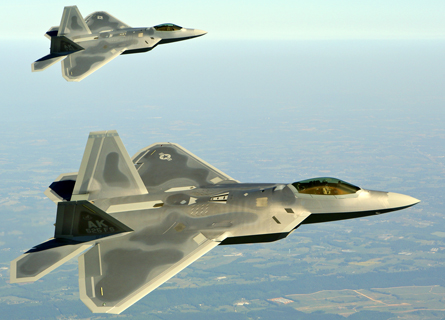US Secretary of Defense Leon Panetta has directed the US Air Force to take additional steps to ensure the safety of pilots flying the Lockheed Martin F-22 Raptor.
Pilots operating the stealthy twin-engine air dominance fighter must remain close enough to an airfield to recover the aircraft quickly in case they encounter problems with their oxygen system.
"All F-22 flights will remain within proximity of potential landing locations to enable quick recovery and landing should a pilot encounter unanticipated physiological conditions during flight," says acting assistant secretary of defense George Little. The order is effective immediately, he adds.
 |
|---|
©Lockheed Martin |
The Department of Defense says that the order is open-ended until Panetta believes that problems with the F-22's oxygen system are mitigated. Pilots flying the aircraft have been afflicted by a number of incidents that resemble hypoxia, but the USAF has yet to find the root cause of the problem.
The USAF says it believes that it has narrowed the potential source of the jet's woes to either a toxin or to the quantity and quality of oxygen flow to the pilot. Decompression sickness has not been ruled out however, the service says. Sources say that the problem could be an insidious form of hyperventilation-if it is not a toxin.
The aircraft was grounded for four months last year due to 14 such incidents which have occurred since 2008. The USAF resumed flying the jets last September despite the fact that it had yet to discover the root cause of the problem. There have about a dozen incidents since the grounding was lifted.
In recent weeks, a number of pilots have refused to fly the F-22 including two aviators who appeared on national television in order to draw attention to their plight. Panetta's decision was due in part to the two men's television appearance.
There will some impact to the Raptor's operations due to the new safety measures. Panetta's order will not affect the 7th Fighter Squadron which is currently deployed to Al Dhafra in the United Arab Emirates. But the directive will impact domestic flights in Alaska.
For the 3d Wing and its reserve associate 477th Fighter Group, based at Joint Base Elmendorf-Richardson, Alaska, the order means that the units will not be flying long-range air sovereignty missions, Little says. Other aircraft will pick up the slack.
Additionally, Panetta is ordering the USAF to speed up the installation of an automatic backup oxygen supply into the entire F-22 fleet. The USAF should complete testing of the automatic backup oxygen system by the end of November. Installations should begin in December with 10 Raptors being retrofitted with the system per month. The USAF has 185 operational F-22s and a handful of test aircraft in its inventory.
Panetta is also directing the USAF to provide him with monthly updates on the service's progress in determining the root cause of the jet's oxygen system maladies.
Source: Flight International























